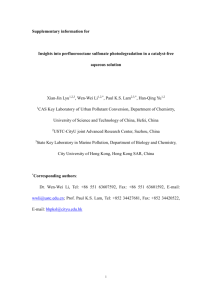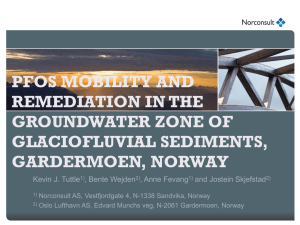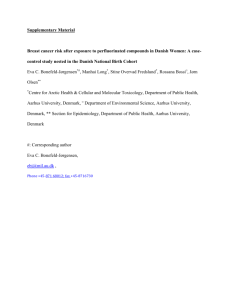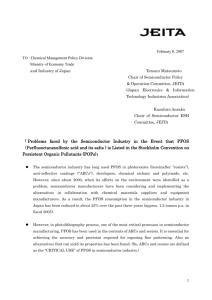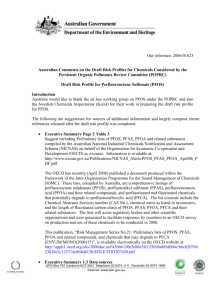Exploration of Management Options for PFOS
advertisement
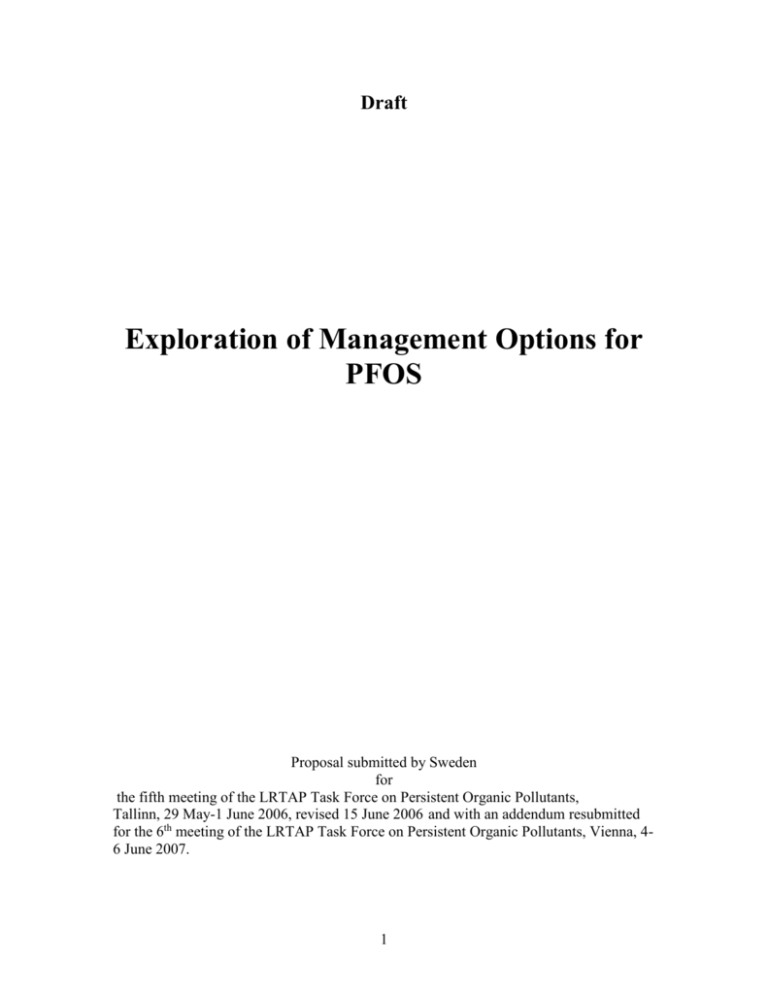
Draft Exploration of Management Options for PFOS Proposal submitted by Sweden for the fifth meeting of the LRTAP Task Force on Persistent Organic Pollutants, Tallinn, 29 May-1 June 2006, revised 15 June 2006 and with an addendum resubmitted for the 6th meeting of the LRTAP Task Force on Persistent Organic Pollutants, Vienna, 46 June 2007. 1 Exploration of Management Options for PFOS Introduction PFOS is an intentionally produced substance with no natural occurrence. It is a fully fluorinated anion, which is commonly used as a salt or incorporated into larger polymers. PFOS can be formed by degradation from a large group of related substances, referred to as PFOS-related substances. PFOS and its related substances are defined as: Perflourooctane sulfonates C8F17SO2X (X= OH, Metal, salt halide, amide, and other derivates including polymers). Due to its surface-active properties it has been used in a wide variety of applications e.g. in textiles, and leather products; metal plating; food packaging; fire fighting foams; floor polishes; denture cleansers; shampoos; coatings and coating additives; in the photographic and photolithographic industry; and in hydraulic fluids in the aviation industry. Current Sources of Emission of PFOS Estimated levels and trends of production and associated emissions in UNECE The total production of PFOS has been significantly reduced from 2000 to 2005 due to a voluntary phase out by industry. The total production volume today in the UNECE region or globally is not known. The use of PFOS in carpets, textiles, paper and packaging, coatings, cleaning products, fire fighting foam and pesticides/insecticides is largely phased out in the UNECE region. Current uses of PFOS are limited to applications where suitable alternatives have not tyet been identified. The current demand (2004) in the European Union was estimated for the ongoing industrial/professional usage of PFOS and PFOS-containing substances (Table 1) xi Table 1: Estimated Current Demand for PFOS-Containing Substances in the Euoropean Union Industry Sector Quantity (kg/year) Photographic industry 1,000 Semiconductor industry 470 Hydraulic fluids 730 Metal plating 10,000 In January 2005, OECD published a report with results from a survey on the production and use of PFOS and related substances in the OECD areai. The responses to the survey were limited and only 10 OECD countries responded to the questionnaire. Eight of these countries were signature to the LRTAP POPs protocol and one conclusion from the survey is that PFOS is still manufactured by Germany (20 – 60 tonnes in 2003) and Italy (< 22 tonnes in 2003). 2 Approximately 587 tonnes of perfluorinated alkyl compounds (PFA) were imported into Canada during 1997-2000. Of this total approximately 318 tonnes were estimated to be PFOS, its salts and its precursors. The manufacture and export of PFOS, its salts and its precursors has been eliminated and it is only imported and used in one industrial sector, according to a survey in 2005. Use of PFOS in manufacturing process Twenty enterprises, of which half are European, have been identified as producers of PFOS related substances in the world during the past decade. It is possible that only half of them are producing such chemicals today. PFAS production in year 2000 has been estimated at 4 650 tonnes per year. The largest parts were used for surface treatment (>2000 tonnes) and paper protection (1500 tonnes) while approximately 900 tonnes were used in performance chemical applications (RPA 2004). The total production has been significantly reduced from 2000 to 2005. 3M which represented more than one quarter of the total production in 2000 had phased out PFOS production by 2003. Former and current processes that use PFOS and associated emissions Due to the persistent nature of PFOS, there is need to take into account the total accumulated production of PFOS since the beginning in the middle of the 1900 century as well as the different uses in the past. It is not possible to make emission scenarios in detail for all PFOS potential precursors since such information is not available, however, since the precursors are degraded to PFOS, which is not further degraded in the environment, they will all contribute to the environmental load for PFOS. Releases of PFOS and its related substances are likely to occur during their whole life cycle. They can be released at their production, at their assembly into a commercial product, during the distribution and industrial or consumer use as well as from landfills after the use of the productsii. Emissions from manufacturing operations prior to the PFOS phase-out were primarily in the form of process waste water discharge to industrial or municipal treatment facilities. Paper recycling facilities may continue to be a source of PFOS emissions as there may also be releases of PFOS during the recycling process. Over half of the PFOS use in Canada was in the form of coating for packaging and paper. The durability of the protective PFAS layer on carpets has been studied by 3M. It is expected that 50% of the FC (fluorochemical) treatment will be removed over the nineyear life of the carpet due to walking and vacuuming, while an additional 45% of the FC treatment will be removed in steam cleaning throughout the carpet lifeiii. It is unlikely that PFOS is transported to remote regions in the vapour phase due to its low vapour pressure. It has been suggested that the presence of PFOS in Arctic wildlife may be due to long-range transport of volatile precursor compounds that degrade to give 3 PFOSiv One of the most likely precursors of PFOS are the electrochemically produced perfluorinated sulphonamidoethanols used to incorporate PFOS into polymeric materialsv and perfluorinated sulphonamides, which has been used in a variety of consumer products and industrial materialsvi A recent study on rainbow trout (Onchorhynchus mykiss) liver microsomes has demonstrated that N-ethyl perfluorooctanesulphonamide (N-EtPFOSA) is a precursor of PFOS in fishvii. These findings combined with the recent measurements of high concentrations of N-EtPFOSA in aquatic organisms from Arctic regionsviii strengthen the hypothesis that perfluorinated sulphonamides are one of the volatile precursors of PFOS transported over long distances to the Arctic. However, the hypothesis that these volatile precursors reach the Arctic latitudes by atmospheric transport has not yet been confirmed by atmospheric measurementsix. Use of products containing PFOS The category of uses where there is no current use or where use is in the process of being phased out consists of carpets, leather, textiles, paper and packaging, coatings, cleaning products, fire fighting foam and pesticides/insecticides. As an example, the majority of PFOS imported into Canada was used in applications involving packaging (56%), rugs and carpets (20%), fire fighting foams (10%), paint and coating additives (8%), chemical formulation, (3%) and water, oil, soil and grease repellents for fabrics (1%). Small quantities of PFOS were also used in the photographic/photofinishing and semiconductor sector. The current use of PFOS is generally limited to those areas where suitable alternatives have not yet been identified. These include the photographic, photolithography and semiconductor applications and chemical formulation, surfactant use in metallic electroplating and hydraulic fluids used in aviation. Emissions during product life cycles Releases of PFOS and its related substances are likely to occur during all stages of their life-cycle e.g. production, product application, distribution, industrial and/or consumer use and disposal. No comprehensive data on present emissions in the UNECE area are available. In a recently published report from Norwayx an inventory was made for the remaining quantities and historic emissions of fire fighting foams containing PFOS in Norway. The quantities of PFOS in the remaining foam were estimated to approximately 22 tons and the dominating uses were in offshore installations. The estimated quantity for fire fighting foams, held in current stock for the European Union, was 122 tonnes in 2004 xi. 4 Average emission/use rates for aqueous film fire fighting foams in Canada are estimated to be in the order of 10-12% per year. Potential emissions to wastewater effluent have been identified from the washing of fabrics and to air from the vacuuming of rugs and carpets. A study shows that 50% of the fluorochemical treatment will be removed over the nine-year life cycle of the carpet due to walking and vacuuming, while an additional 45% of the fluorochemical treatment will be removed in steam cleaning throughout the carpet life. Emissions to air from the use of after market applications for oil, soil and grease repellents for apparel, upholstery and carpets are estimated to be minimal but will contribute in the form of material disposal. For the semiconductor industry emissions from critical uses were 54 kg in Europe which is approximately 10% of its use. Waste containing PFOS Recent studies confirm that WWTPs are significant sources for introduction of perfluoroalkyl substances (including PFOS) to natural waters. Six WWTPs was analysed in a study in New York State and PFOS was found to be ubiquitous in the effluents of these WWTPsxii There are no data to reflect the potential Canadian releases from the use and final disposal of imported finished products that may contain PFOS as part of the fabric finishes or coatings. Environmental releases from these surface treatments are expected during use and may involve discharges to process wastewater and air during initial applications. Additional wastes occur from cutting, shearing or packaging operations and are generally landfilled or recycled. End use of consumer articles will create additional losses. Vacuuming and cleaning of carpets creates releases and final disposal of the treated carpets is generally to the landfill. The use of after market applications for apparel, upholstery and carpet will also result in additional landfill material. A study of the possible releases from landfills and biosolid application fields has been commissioned by Environment Canada. The final results of this study will be available in June 2006. In the case of fire fighting foams, final disposal would be to waste treatment facilities as well as uncontrolled releases to the terrestrial or aquatic environment depending on the nature and location of the fire and the type (fixed versus portable) of equipment used to contain it. Possible alternatives for existing uses The possible alternatives identified for the photographic industry are: digital techniques, telomer-based products, C3 and C4 perfluorinated compounds, hydrocarbon surfactants and silicone products. According to the European Semiconductor Industry Association, while new techniques are being developed where PFOS-related substances are not being used, there are no 5 alternatives available that would allow for comprehensive substitution of PFOS in critical applications. For hydraulic oils a change in the formulation of the oil seems to be the only alternative solution. This will, however, demand a comprehensive testing together with an approval from the airplane manufacturers, as safety standards within this industry are very high. For decorative chromium plating an alternative process already exists. In this process chromium(III) is used and no PFOS-chemicals are necessary. For hard plating, however, the process with chromium(III) does not function as well. Instead larger closed tanks, or increased ventilation combined with extraction of chromium(VI), are suggested as alternative solutions for the applications where a use of chromium(III) is not possible yet. In both cases exposure to chromium(VI), a known human carcinogen, will decrease, which is an added benefit of the alternatives. Possible management actions For the surface protecting uses of PFOS e.g. in of carpets, leather, textiles, paper and packaging, coatings, cleaning products and for pesticides/insecticides substitution has largely occurred and there are alternatives which are judged to be less environmentally damaging. Further investigation of some of the alternatives with respect to their costs and environmental and health effects is needed. For photography the potential alternatives identified are: digital techniques, telomerebased products, C3 and C4 perfluorinated compounds, hydrocarbon surfactants and silicone products. The reduction by 83% in the EU photographic industry since 2000 has been estimated to cost € 20-40 M per year. Further reductions will cost more per unit since the uses that are easy to substitute have been eliminated first and the remaingn are most likely more difficult to substitute. For photolithography in the semiconductor industry some uses are presently vital. Once substitutes are identified, the bulk of the costs are likely to be related to the change in technology, i.e. investment costs, rather than running the new process. New techniques are being developed for semiconductors where PFOS-relarted substances are not being used, but there are no alternatives available at present that would allow for comprehensive substitution of PFOS usies in critical applications. The global semiconductor industry has recently announced a commitment to curtail PFOS use and its intention to work to identify substitutes in critical applications. The industry has committed to end non-critical uses in the UNECE region by May 2007. Management options should consider time frames for the availability of substitutes. For metal plating, alternative processes already exist for decorative chromium plating. In this process chromium(III) is used and no PFOS-chemicals are necessary. For hard plating the process with chromium(III) process does not function as well. Larger closed tanks, or increased ventilation combined with extraction of chromium(VI) are suggested as alternative solutions for the applications where a use of chromium(III) is not yet 6 possible. In both cases exposure to chromium(VI), a known human carcinogen, will decrease, which is an added benefit of the alternatives. The financial gain of not using PFOS may vary among enterprises according to their size and could be as large as the cost of a new system. For hydraulic fluids a change in the formulation of the oil seems to be the only alternative solution. This will, however, demand a comprehensive testing together with an approval from the airplane manufacturers, as safety standards within this industry are very high. At present there is point uncertainty about alternative technologies/substances. For waste containing PFOS consideration should be given to setting up a collection programme for fire fighting foams and hydraulic fluids used in aviation. In the EU hydraulic fluids used in aviation are managed as hazardous waste. Cost implications The cost of eliminating the surface protecting uses of PFOS is very low since industry has largely substituted such use already (EU COM 2005). There are alternatives which are judged to be less environmentally damaging. For the other uses, photographic industry, photolithography and semiconductors, metal plating and hydraulic fluids there is a need for special conditions. It would be difficult to eliminate these uses at short notice. Photography The reduction by 83 % in the EU photographic industry has been estimated to cost € 2040 M/year during a few years (RPA 2004). Further reductions will cost more per unit since the uses that are easy to substitute have been eliminated first and the remaining are most likely more difficult (costly) to substitute. Semiconductors The total turnover of the semiconductor industry is € 213 billion and employs about half a million people. More than 60 % of employment is in the USA and EU (SIA 2006). Semiconductors constitute an important part of our modern society and they are used in very many products. This does not automatically imply that PFOS, which is used in the process, has such high value. Many functions can be materialized with alternative substances. The main reason for using PFOS is high quality demands, i.e. precision in the production process in order to guarantee good function. For some uses this is vital and a total elimination without time derogations would be very costly. The choice between applying PFOS or an alternative substance is a function of several factors, of which one is the cost of PFOS. The main impediments that the industry faces today are however related to the need for substitutes that will provide a comparable level of performance to PFOS in advanced photolithographic applications where accuracy 7 is essential. The bulk of the costs are therefore likely to be related to the change in technology, i.e. investment costs, rather than running the new processes. Emissions from semiconductor industry may be less than half a percent of total PFOSemissions (SIA 2006. The statement can not be confirmed since data on all uses and emissions are not available.). This proportion is increasing as PFOS use is reduced in other sectors. The environmental and health risks of accepting this production is very small compared to impacts of other uses. Metal plating The cost of improved ventilation with extraction, which is the recommended substitute for PFOS based mist suppressants, has been calculated to be € 3400 per year in each production unit where the investment period is 15 years (RPA 2004). Assuming a few hundred units in the EU the total cost would be one or two million euros. PFOS will not be needed if improved ventilation is used. The economic gain of not having to use PFOS may be as large as the cost of the new system. The net cost is, thus, rather low but may vary among enterprises. Air pollution control is relatively more costly to change for small production units than for large. The possibility to substitute chromium(VI) for other metal plating is mainly motivated by the carcinogenic risks involved. If such substitution is successful, PFOS would not be needed in the metal plating industry. This should be seen as a positive side effect rather than a cost for reducing the use of PFOS. Hydraulic oils There are no economic calculations available. Fire fighting foam and cost-effectiveness Fire fighting foams are expected to have the longest in use lifespan since its use is based on fire incidents and many organizations have already eliminated the use of fire fighting foams for training exercises. An acceleration of the fire fighting foam use to achieve a more rapid phase-out is unlikely to be pursued. No significant management costs are anticipated with this turnover of existing PFOS based stock. It is cost-effective to destroy the stocks when comparing with emission reduction options from other uses. Costs of destruction of foam are about € 1000/tonne and new foam € 5000/tonne (the cost of early renewal is much lower), while the cost of reducing the use of PFOS for photolithography and semiconductors is € 2 M/tonne or more (Swedish estimates and RPA 2004). The risks are also greater since the foam is spread directly into the environment when used. The stock in the EU is 122 tonnes which shows that a significant effect can be achieved. Even if only a fraction of the stock would be used it is costeffective to destroy the stock when comparing with the other options. 8 Costs for consumers Except where there are no substitutes, price increases for consumers are generally expected to be very low since the alternatives are not very costly and the PFOS part is small in most final products. The possible threat to the interests of consumers comes from a loss of function that may be the result of elimination of uses where there are no available alternatives. The costs could become very large, in particular for semiconductors and hydraulic oils in aviation, in case of a total elimination without time derogations. Costs for state budgets The costs for governments may depend on the action taken. There may be costs associated with mandated control measures, e.g. in metal plating, photographic industry and airplane maintenance. There may also be costs associated with monitoring and controlling consumer products containing PFOS, especially imported products. If taxes/charges are used at the national level to speed up the phase out process, governments would receive revenue that could compensate for the control costs. 9 Addendum Additional information received in March 2007, collected through questionnaires and not evaluated in the above report. In response to a questionnaire developed by the Netherlands to assist the Task Force in the evaluation of management options for the substances under consideration, responses for PFOS were obtained from the following Parties to the Protocol (P), non-Parties (nonP) and observers (Obs): Belgium (P) Canada (P) Cyprus (P) France (P) Germany (P) Ireland (non-P) Netherlands (P) Switzerland (P) United Kingdom (P) United States (non-P) Semiconductor industry (Obs) Several questionnaires referred to information that had already been included in the report to the 5th meeting of the Task Force in June 2006. The additional information is summarized below. All figures are expressed as PFOS. National and regional control actions taken Canada has proposed regulation to prohibit the production and use of PFOS and its salts and substances that contain on of the following groups C8F17SO2, C8F17SO3 or C8F17SO2N (Canada Gazette, vol. 140, No 50, December 16, 2006). The European Union has by adopting Directive 2006/122/EC of the European Parliament and of the Council of 12 December 2006 amended for the 30th time Council Directive 76/769/EEC on the approximation of the laws, regulations and administrative provisions of the Member States relating to restrictions on the marketing and use of certain dangerous substances and preparations (perfluorooctane sulfonates). The United States Environmental Protection Agency (US EPA) has adopted federal Significant New Use Rules (SNURs) for 88 PFOS substances which apply to new manufacture and new uses of these substances(40CFR 721.9852). A proposed SNUR for 183 additional perfluoroalkyl sulfonate substances was posted in April 2006 for public consultations, and the publication of the final SNUR is expected in 2007. 10 Total use Switzerland gives several estimates for the current use of PFOS ranging from 230 kg/yr to 5 tons/yr. The United States estimates total use to be less than 7.98 tons/yr (2006). Semi-conductors Ireland reports import and use of 10 kg during 2006. The semi-conductor industry reports a non-critical use in the EU of 347 kg/yr for 2004. Figures are also given for countries outside the UNECE region (Japan). Emissions in the EU are estimated at 54 kg/yr to water (2004) for critical uses and 298 kg/yr for non-critical uses (2004). Metal plating Canada reports an estimated 3 metric tons used for metal plating in 2004. For the same year and purpose they report an import of 3 tons from the United States. France reports 200 kg used for metal plating during 2006. Fire fighting foams Canada reports use of 300 kg during 2004. Stockpiles and waste Canada reports an estimated 3 tons of PFOS in stockpiles of fire fighting foams, of whihc 10% is estimated to be expended each year. Switzerland reports an estmate fo the flow of PFOS from use to waste ranging from 5 to 17 tons/yr before 3M production ceased in 2001. 11 i Results Of Survey On Production And Use Of PFOS, PFAS and PFOA, Related Substances And Products/Mixtures Containing These Substances, OECD, ENV/JM/MONO 2005, 1 ii Sulphonated Perfluorochemicals in the Environment: Sources, Dispersion, Fate and Effects (AR2260545). 3M Company, St Paul, MN. 2000 Sulphonated perfluorochemicals: U.S. release estimation – 1997. Part 1: Life-cycle waste stream estimates, Final report, 3M, Battelle Memorial Institute, Columbus, Ohio, United States of America, 2000 iii iv Martin, J.W.; Muir, D. C. G.; Moody, C. A..; Ellis, D.A..; Kwan, W. C.; Solomon, K. R.; Mabury, S. A. Collection of airborne fluorinated organics and analysis by gas chromatography/chemical ionization mass spectrometry. Anal. Chem. 2002, 74, 584-590. v Kissa, E. Fluorinated Surfactants and repellents, 2nd ed.; Marcel Dekker: New York, 2001. vi U.S. Environmental Protection Agency. Perfluorooctane sulphonates; proposed significant new use role. Fed Regist. 2000, 65, 62319-62333 vii Tomy, G. T.; Tittlemier, S. A.; Palace, V. P.; Budakowski, W. R.; Braekevelt, E.; Brinkworth, L.; Friesen, K. Biotransformation of N-ethyl perfluorooctanesulphonamide by rainbow trout (Onchorhynchus mykiss) liver microsomes. Environ. Sci. Technol. 2004, 38, 758-762 viii Tomy, G.T.; Budakowski, W.; Halldorson, T.; Helm, P.A.; SternG. A.; Freisen, K.; Pepper, K.; Tittlemier, S. A.; Fisk, A. T. Fluorinated organic compounds in an eastern Arctic marine food web. Environ.Sci Technol. 2004, 38, 6475-6481 ix Bossi, R.; Riget, F. F.; Dietz, R. Temporal and spatial trends of perfluorinated compounds in ringed seal (Phoca hispida) from Greenland. Environ. Sci. Technol. 2005, 39, 7416-7422 x Kartlegging av PFOS I brannskum, SFT report, TA-2139/2005, ISBN 82-7655-275-7, (Summary available in English), http://www.sft.no/publikasjoner/kjemikalier/2139/ta2139.pdf xi Risk & Policy Analysts Limited (RPA) in association with BRE Environment, Perfluorooctane Sulphonate – Risk reduction strategy and analysis of advantages and drawbacks, Final Report prepared for Department for Environment, Food and Rural Affairs and the Environment Agency for England and Wales, 2004. xii Sinclair, E.; Kannan, K. Mass Loading and Fate of Perfluoroalkyl Surfactants in Wastewater Treatment Plants, Environ. Sci. Technol., 40 (5), 1408 -1414, 2006 12
